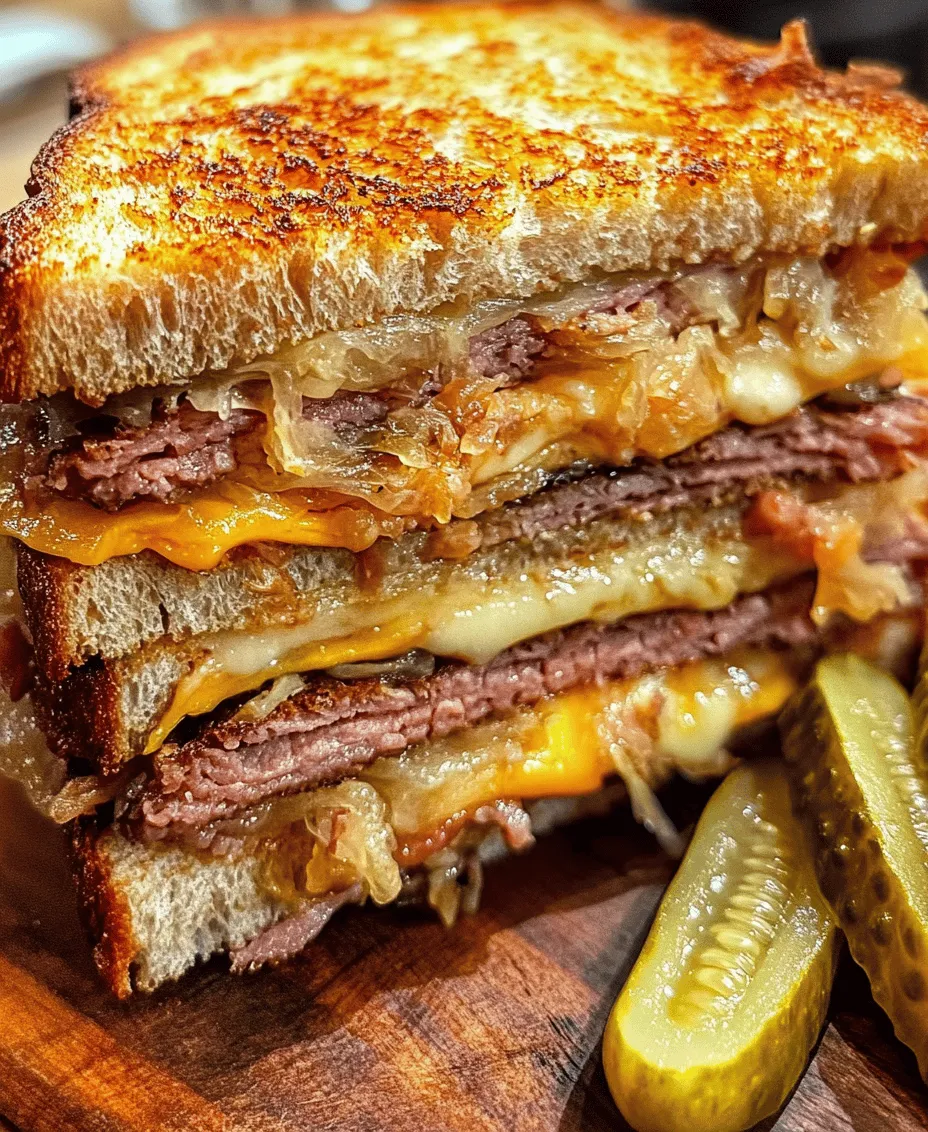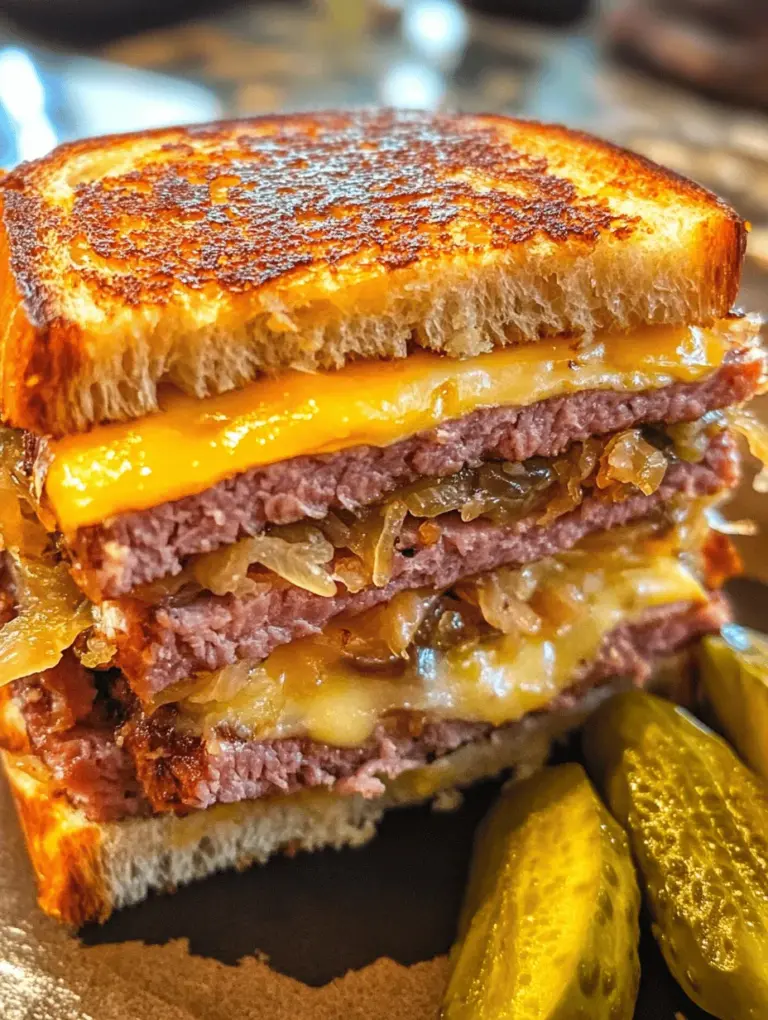Introduction
The pastrami sandwich is more than just a meal; it is a beloved classic that embodies the heart of deli cuisine. This iconic sandwich, often found in bustling Jewish delis across America, has become a staple of comfort food, celebrated for its unique combination of flavors and textures. Picture this: smoky, tender slices of pastrami piled high, creamy Swiss cheese oozing from the side, tangy sauerkraut adding a zesty crunch, and a dollop of mustard punctuating every bite. Each element harmonizes beautifully to create a sandwich that is not only satisfying but also layered with complex flavors that tell a story of culinary tradition.
Originating from Eastern European Jewish communities, pastrami made its way to the United States in the late 19th century, quickly establishing itself as a quintessential part of American cuisine. The sandwich gained immense popularity, particularly in New York City, where delis like Katz’s and Carnegie Deli elevated it to legendary status. Today, the pastrami sandwich remains a symbol of hearty, flavorful food, cherished by many and often enjoyed during casual lunches or festive gatherings.
In this recipe, we delve deeper into the essential components that make the ultimate pastrami sandwich, exploring the origins and characteristics of each ingredient. We will also guide you through step-by-step instructions to create a sandwich that does justice to its rich history and flavor profile.
Understanding the Ingredients
To craft the perfect pastrami sandwich, it’s essential to understand the key ingredients that contribute to its allure. Each component plays a significant role, enhancing the overall taste and texture of this iconic dish.
Pastrami
At the heart of any pastrami sandwich lies the pastrami itself. This flavorful meat is typically made from beef, specifically the brisket cut, which is cured, seasoned, and smoked to perfection. The origins of pastrami can be traced back to Romanian Jewish immigrants who brought their culinary traditions to America. The preparation involves a meticulous process of brining the meat with a blend of spices, including black pepper, coriander, and garlic, followed by a smoking phase that imparts a distinctive flavor.
Quality is paramount when selecting pastrami; for the best results, sourcing from reputable delis or artisanal butchers is crucial. Look for pastrami that is thickly sliced, with a deep smoky aroma and a tender, juicy texture. The depth of flavor in the pastrami sets the foundation for a truly memorable sandwich.
Rye Bread
The choice of bread is just as important as the meat. Rye bread, with its dense structure and slightly tangy flavor, pairs perfectly with the rich taste of pastrami. This type of bread has a unique texture that can hold up under the weight of stacked ingredients, providing a sturdy base for the sandwich. Its complex flavor profile complements the smoky notes of the pastrami, creating a delightful contrast.
There are variations of rye bread available, including light, dark, and marbled rye. Dark rye, often made with whole grain flour, can add an earthy depth to the sandwich, while marbled rye provides a visually appealing twist. When selecting rye bread, opt for a freshly baked loaf for the best flavor and texture.
Swiss Cheese
Adding a layer of Swiss cheese to the pastrami sandwich enhances its creaminess and provides a delightful melt. Known for its mild, nutty flavor and characteristic holes, Swiss cheese has a smooth texture that complements the savory pastrami beautifully. As it melts, it creates a luxurious, gooey layer that binds the sandwich together.
The key to using Swiss cheese is to ensure it’s of high quality. Look for varieties made from whole milk, as they tend to melt better and deliver a richer flavor. Aged Swiss cheese can also be an excellent choice, providing a more pronounced taste that stands up to the bold flavors of the pastrami.
Sauerkraut
Incorporating sauerkraut into the pastrami sandwich not only adds a crunchy texture but also introduces a tangy brightness that cuts through the richness of the meat and cheese. Sauerkraut is fermented cabbage that offers numerous health benefits, including probiotics that support gut health. This fermented ingredient also contributes a unique flavor that enhances the overall taste of the sandwich.
When choosing sauerkraut, look for options that are naturally fermented and free from preservatives. You can either purchase it from a store or make your own at home for a fresher taste. The key is to ensure that the sauerkraut is well-drained before layering it on the sandwich, as excess liquid can make the bread soggy.
Mustard
Mustard is a classic condiment that plays a pivotal role in balancing the flavors of the pastrami sandwich. Its tangy and slightly spicy notes provide a sharp contrast to the richness of the meat and cheese, elevating the entire eating experience. From yellow mustard to spicy brown or even Dijon, the choice of mustard can influence the overall flavor profile of the sandwich.
When selecting mustard, consider your personal preference for heat and acidity. A good quality mustard, whether it’s a smooth spread or a grainy texture, will enhance the flavors without overpowering them. Spread a generous layer on the inside of the bread for the best results.
Olive Oil and Smoked Paprika
To take your pastrami sandwich to the next level, consider adding a drizzle of olive oil and a sprinkle of smoked paprika. Olive oil adds a rich mouthfeel and enhances the overall flavor, while smoked paprika introduces a subtle smokiness that complements the pastrami beautifully. This combination can also help to create a crispy crust when toasting the sandwich.
Both ingredients should be used sparingly to avoid overwhelming the other flavors. A light drizzle of olive oil on the bread before toasting can add a delightful crunch, while a pinch of smoked paprika can enhance the smoky notes of the pastrami, creating a layered and complex flavor profile.
Step-by-Step Instructions for the Perfect Pastrami Sandwich
Now that we’ve explored the essential ingredients, let’s dive into the step-by-step instructions for assembling the perfect pastrami sandwich. The process is straightforward, but attention to detail will ensure that every bite is packed with flavor.
Preparing the Pastrami
The first step in creating your pastrami sandwich is to prepare the pastrami. If you’re using pre-packaged pastrami, you can skip this step and move straight to assembly. However, if you have a whole piece of pastrami, here’s how to prepare it for the sandwich:
1. Slice the Pastrami: Using a sharp knife, slice the pastrami against the grain into thin, even slices. The thickness of the slices is key; aim for about 1/4 inch thick to ensure a tender bite without being overwhelming.
2. Sauté the Pastrami: In a skillet over medium heat, add a drizzle of olive oil. Once the oil is hot, add the sliced pastrami in a single layer. Sauté for about 2-3 minutes, allowing it to warm through and develop a slight crust. If desired, season lightly with smoked paprika and black pepper for added flavor.
3. Temperature Control: Monitor the heat to avoid overcooking the pastrami, which can lead to dryness. The goal is to heat the meat while retaining its moisture and flavor.
Toasting the Bread
Toasting the rye bread is an essential step that enhances both the texture and flavor of the sandwich. Here’s how to do it:
1. Preheat the Skillet: In the same skillet used for the pastrami, wipe it clean and return it to the stove over medium heat. You can also use a separate skillet or a panini press if available.
2. Prepare the Bread: Take two slices of rye bread and drizzle a small amount of olive oil on one side of each slice. This will help achieve a golden, crispy crust.
3. Toast the Bread: Place the slices of bread, oiled side down, onto the skillet. Toast for about 2-3 minutes or until golden brown. Flip the bread and toast the other side for an additional 1-2 minutes, allowing it to become slightly crispy.
4. Keep Warm: Once toasted, remove the bread from the skillet and set it aside, keeping it warm while you finish preparing the sandwich.
Layering the Ingredients
With the pastrami warmed and the bread toasted, it’s time to layer the ingredients and assemble your pastrami sandwich:
1. Layer the Pastrami: Take one slice of toasted rye bread and lay it down on a clean surface. Pile on the sautéed pastrami, ensuring it covers the entire slice evenly.
2. Add Swiss Cheese: Place a generous slice of Swiss cheese on top of the pastrami. The heat from the meat will begin to melt the cheese slightly, creating a delicious blend of flavors.
3. Top with Sauerkraut: Spoon a layer of well-drained sauerkraut over the cheese, distributing it evenly to ensure every bite has a touch of tanginess.
4. Spread Mustard: On the second slice of toasted rye bread, spread a layer of your chosen mustard. Be generous but balanced—too much mustard can overpower the other flavors.
5. Combine the Sandwich: Carefully place the second slice of bread on top of the layered ingredients, mustard side down. Press gently to compact the sandwich slightly.
6. Optional Final Toast: If desired, you can return the assembled sandwich to the skillet for a minute on each side to further crisp the exterior and melt the cheese.
Now that you have successfully prepared your ultimate pastrami sandwich, you are well on your way to enjoying a hearty, flavorful meal that pays homage to its rich culinary history. Stay tuned for the continuation of this article, where we will delve into additional tips for achieving the best results and answer some common questions about this delicious deli classic.

Layering Technique for Maximum Flavor
Creating the perfect pastrami sandwich is not just about the ingredients; it’s also about how you assemble them. A well-layered sandwich ensures that each bite bursts with flavor. Start with a generous base of mustard on the bottom slice of bread. Then, layer on your pastrami, allowing it to slightly overlap for a more substantial bite. Next, add a layer of cheese, preferably Swiss or provolone, which melts beautifully and complements the smokiness of the meat.
For added texture, consider incorporating thinly sliced pickles or coleslaw atop the cheese. This will introduce a delightful crunch that contrasts with the richness of the pastrami. Finally, place your top slice of bread and gently press down to help meld the flavors together, ensuring you don’t lose any of that savory goodness with each bite.
Grilling the Sandwiches
Grilling your pastrami sandwich is where the magic truly happens. Start by preheating your skillet or griddle over medium heat. It’s essential to use a pan that retains heat well for an even cook. While the pan heats up, butter the outside of both slices of bread generously. The butter not only adds flavor but also helps achieve that golden-brown crust we all love.
Place the sandwich in the pan once it’s hot, pressing it down slightly with a spatula to ensure even contact with the surface. Cook for approximately 3-4 minutes on one side, or until golden brown. Carefully flip the sandwich, and if you want to ensure the cheese melts perfectly, you can cover the pan with a lid. This traps heat and allows the cheese to melt without burning the bread.
Keep an eye on the sandwich to avoid burning, adjusting the heat as necessary. Once both sides are beautifully browned and the cheese is melty, remove the sandwich from the heat and let it rest for a minute. This rest period allows the flavors to set and makes slicing easier.
Serving Suggestions
A pastrami sandwich is a meal in itself, but it can be paired with various sides to enhance your dining experience. Classic accompaniments include dill pickles or pickled vegetables, which provide a sharp contrast to the savory meat. A side of coleslaw is another excellent choice, adding crunch and creaminess that balances the sandwich’s richness.
For those who enjoy a bit of heat, consider serving with a side of spicy mustard or horseradish. These toppings not only amplify the sandwich’s flavor profile but also awaken the palate. If you’re feeling adventurous, sweet potato fries or crispy onion rings can add a satisfying crunch to the meal.
Nutritional Information
Understanding the nutritional content of your pastrami sandwich can help you make informed choices. Here’s a breakdown of a typical sandwich made with two slices of rye bread, 4 ounces of pastrami, one slice of Swiss cheese, and condiments:
– Calories: Approximately 600-700 calories
– Protein: 30-35 grams
– Fat: 30-35 grams
– Carbohydrates: 50-60 grams
For those with dietary restrictions, there are several modifications you can make. Gluten-free bread options are widely available and can easily substitute regular bread. If you’re looking for a vegetarian alternative, consider using smoked tempeh or a hearty roasted vegetable mix to replicate the savory flavor profile of pastrami.
Variations of the Pastrami Sandwich
The pastrami sandwich is versatile, and there are several delightful variations to explore:
Classic New York Style
The quintessential New York pastrami sandwich is a towering stack of meat, typically slathered with spicy brown mustard and served on rye bread. You might also add sauerkraut or a slice of cheese for extra richness. This variation is often enjoyed as is, but some prefer to add a side of potato salad or matzo ball soup for a true deli experience.
Spicy Pastrami Sandwich
For those who enjoy a kick, try a spicy pastrami sandwich. Add spicy mustard or sliced jalapeños for an extra layer of heat. Another option is to mix in pepper jack cheese, which can enhance the sandwich’s flavor and provide a delightful heat that pairs perfectly with the smoky pastrami.
Open-Faced Pastrami Sandwich
An open-faced pastrami sandwich offers a unique twist. Instead of two slices of bread, use one thick slice as a base and pile it high with pastrami, cheese, and toppings. This style allows for a more substantial presentation and is perfect for those who want to focus on the flavors of the pastrami and toppings without the bread overwhelming the dish.
Cultural Impact and History of the Pastrami Sandwich
The pastrami sandwich has a rich history that traces back to the 19th century when Jewish immigrants brought the recipe from Romania to the United States. Initially, pastrami was made from beef brisket, cured with spices, and smoked, becoming a staple in Jewish delis across America. The sandwich gained fame in New York City, where it became a symbol of Jewish-American cuisine.
Within Jewish communities, the pastrami sandwich represents more than just a meal; it embodies cultural heritage and tradition. It has made its mark on American food culture, with delis like Katz’s Delicatessen becoming iconic landmarks. The pastrami sandwich has transcended its origins, becoming a beloved dish enjoyed by people of all backgrounds.
Conclusion
The pastrami sandwich is a culinary delight that combines rich flavors, a variety of textures, and a storied history. Its layering technique ensures that each bite is packed with savory goodness, while the grilling method provides a satisfying crunch and melted cheese. Whether you’re enjoying it in its classic form or experimenting with variations, the pastrami sandwich is sure to please.
Making this sandwich at home allows you to appreciate not only the cooking process but also the cultural significance behind it. So gather your ingredients, follow the steps, and indulge in the smoky, savory flavors of a homemade pastrami sandwich. You’ll not only savor the fantastic taste but also celebrate the rich tapestry of traditions that this iconic dish represents.


